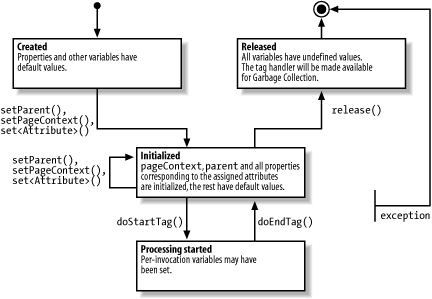The Tag-Handler Lifecycle and What It Means to You
Creating new objects is a relatively expensive operation in Java. For high-performance applications, it’s common to try to minimize the number of objects created and try to reuse the same objects instead. The lifecycle defined for a tag handler allows a tag handler instance to be reused within the code generated for JSP pages under certain circumstances.
The tag-handler lifecycle details are pretty complex and are mostly
of interest to container developers. But you need to know how the
lifecycle relates to instance reuse to ensure that your tag handlers
work correctly in a container that takes advantage of reuse for
improved performance. Figure 20-5 shows a state
diagram for a tag handler that implements just the
Tag interface.

Figure 20-5. Lifecycle for a tag handler implementing the Tag interface
When the tag instance is created, all instance variables have default
values; then all setter methods (setPageContext( ), setParent( ), and all setters for
attributes) are called. This brings the instance to a state where
it’s initialized for use. The doStartTag( )
method is then called. This method may
set instance variables to values that are valid only for the current
invocation. The doEndTag( )
method is called if no exception is
thrown by doStartTag( ) or while processing the element’s body. The tag handler instance may then be reused ...
Get JavaServer Pages, Second Edition now with the O’Reilly learning platform.
O’Reilly members experience books, live events, courses curated by job role, and more from O’Reilly and nearly 200 top publishers.

